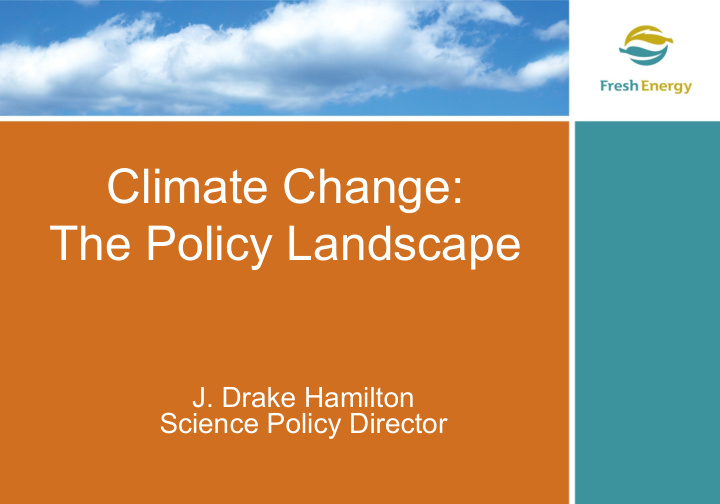



Climate Change: The Policy Landscape J. Drake Hamilton Science Policy Director
The National Academy of Sciences, May 2011 “Global climate change caused by human activities is occurring now, and it is a growing threat to society … the time to control greenhouse gas emissions is now.”
Agenda Minnesota ’ s Clean Energy Path
NEXT GENERATION ENERGY ACT 2007 MN clean energy policies: • 1.5 percent per year energy savings goals • 25 percent by 2025 Renewable Electricity Standard • Science-based limits on our global warming pollution
Cle lean E n Ene nergy, C , Cli lima mate, a , and nd H Healt lth A series of free, public forums with polar explorer Will Steger and Fresh Energy ’ s J. Drake Hamilton Minne nnesota i is o on a n a c cle lean e n ene nergy p y path h tha hat i is b bring nging ng b bene nefits t to hu huma man n he healt lth a h and nd o our a air, w , water, a , and nd na natural l resour resources ces. Hear Will Steger, Minnesota ’ s own eyewitness to climate change, present his vivid, firsthand account with stunning photographs from his expeditions. J. Drake Hamilton, science policy director at Fresh Energy, will describe effective clean energy and clean air solutions that benefit Minnesota ’ s economy.
November 10, 2012 Lord o of L Life L Luthe heran C n Chu hurch, B h, Baxter November 11, 2012 Our S Savior ’ s L Luthe heran C n Chu hurch, N h, New Ulm Ulm November 13, 2012 Wino nona na S State U Uni niversity, W , Wino nona na November 26, 2012 Conc ncordia C Colle llege, M , Moorhe head November 29, 2012 John M hn Marsha hall H ll High S h Scho hool, R l, Roche hester December 3, 2012 Bethle hlehe hem L m Luthe heran C n Chu hurch, S h, St. C . Clo loud December 4, 2012 Vinje nje L Luthe heran C n Chu hurch, W h, Willma llmar December 9, 2012 Northw hwestern C n Colle llege/Bethe hel U l Uni niversity
Increase the Renewable Electricity Standard
Minnesota has a great wind resource Percent of electricity from wind power, 2011
Strengthen the Energy Efficiency Resource Standard
10 percent solar by 2030
Workable plan to meet carbon pollution reduction goals
Governor Mark Dayton, State of the State address, February 6, 2013 “ Even more alarming is that our state and our nation are still not doing enough to reverse this path toward global catastrophe before it is too late.” "I challenge this Legislature to work again with our state's visionary clean-energy advocates, large energy providers, large energy users, other stakeholders, and my administration ... to use your past achievements as springboards for Minnesota's next big leap toward a sustainable energy future."
The Clean Air Act 19 1970 • became law to protect human health and welfare 19 1990 • bipartisan update signed by President Bush to tackle new air pollution problems 20 2011 and nd 2 2012 • scientific findings call for modernizing standards to include mercury, soot, ozone, and carbon
The Clean Air Act 2012 EPA p proposed ne new s source c carbon s n stand ndards f for power p pla lant nts 2013 Fina nali lize ne new s source s stand ndards First-e -ever c carbon li n limi mits f for e existing ng p power p pla lant nts
J. Drake Hamilton Science Policy Director Fresh Energy hamilton@fresh-energy.org @freshe hene nergy February 27, 2013
www.fresh-energy.org
ENERGY ¡for ¡our ¡homes, ¡farms ¡ ¡ and ¡businesses ¡
Is it natural?
Projected Climate Changes in Minnesota by 2100 • Temperature – Winter + 6-10 °F – Summer +7-16 ° F – Growing season 3-6 weeks longer • Precipitation – Winter +15-40% – Summer –15% – Drier soils, more droughts Source: Bob Allan, NREL • More extreme events – storms, floods – Could be 50-100% more frequent than now • Ice cover decline will continue
Recommend
More recommend